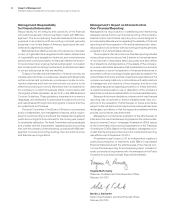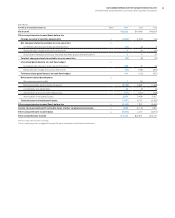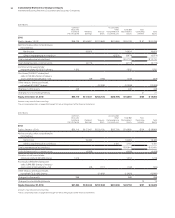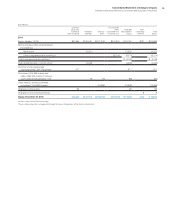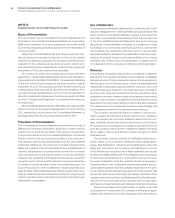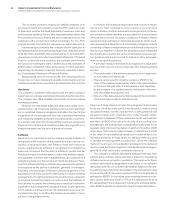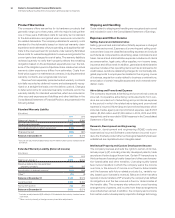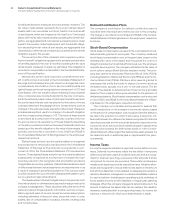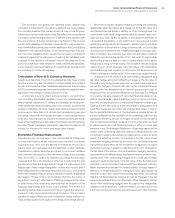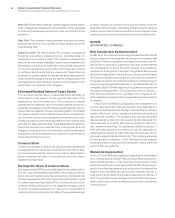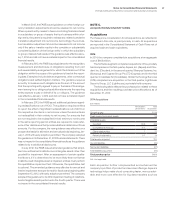IBM 2014 Annual Report Download - page 89
Download and view the complete annual report
Please find page 89 of the 2014 IBM annual report below. You can navigate through the pages in the report by either clicking on the pages listed below, or by using the keyword search tool below to find specific information within the annual report.Notes to Consolidated Financial Statements
International Business Machines Corporation and Subsidiary Companies
88
The company performs ongoing profitability analyses of its
services contracts accounted for under the POC method in order
to determine whether the latest estimates of revenues, costs and
profits require updating. If at any time these estimates indicate that
the contract will be unprofitable, the entire estimated loss for the
remainder of the contract is recorded immediately. For non-POC
method services contracts, any losses are recorded as incurred.
In some services contracts, the company bills the client prior to
recognizing revenue from performing the services. Deferred income
of $6,352 million and $7,153 million at December31, 2014 and 2013,
respectively, is included in the Consolidated Statement of Financial
Position. In other services contracts, the company performs the
services prior to billing the client. Unbilled accounts receivable of
$1,833 million and $2,053 million at December31, 2014 and 2013,
respectively, is included in notes and accounts receivable-trade in
the Consolidated Statement of Financial Position.
Billings usually occur in the month after the company performs
the services or in accordance with specific contractual provisions.
Unbilled receivables are expected to be billed within four months.
Hardware
The company’s hardware offerings include the sale or lease of
system servers, storage solutions and the sale of semiconductors.
The company also offers installation services for its more complex
hardware products.
Revenue from hardware sales and sales-type leases is rec-
ognized when risk of loss has transferred to the client and there
are no unfulfilled company obligations that affect the client’s final
acceptance of the arrangement. Any cost of standard warranties
and remaining obligations that are inconsequential or perfunc-
tory are accrued when the corresponding revenue is recognized.
Revenue from rentals and operating leases is recognized on a
straight-line basis over the term of the rental or lease.
Software
Revenue from perpetual (one-time charge) license software is
recognized at the inception of the license term if all revenue rec-
ognition criteria have been met. Revenue from term (recurring
license charge) license software is recognized on a straight-line
basis over the period that the client is entitled to use the license.
Revenue from post-contract support, which may include unspeci-
fied upgrades on a when-and-if-available basis, is recognized on a
straight-line basis over the period such items are delivered. Reve-
nue from software hosting or software-as-a-service arrangements
is recognized as the service is delivered, generally on a straight-
line basis, over the longer of the term of the arrangement or the
expected period of the customer relationship. In software hosting
arrangements, the rights provided to the customer (e.g., ownership
of a license, contract termination provisions and the feasibility of
the customer to operate the software) are considered in determin-
ing whether the arrangement includes a license. In arrangements
which include a software license, the associated revenue is rec-
ognized according to whether the license is perpetual or term,
subject to the guidance above.
In multiple-deliverable arrangements that include software
that is more than incidental to the products or services as a
whole (software multiple-deliverable arrangements), software
and software-related elements are accounted for in accordance
with software revenue recognition guidance. Software-related
elements include software products and services for which a soft-
ware deliverable is essential to its functionality. Tangible products
containing software components and non-software components
that function together to deliver the tangible product’s essential
functionality are not within the scope of software revenue recogni-
tion guidance and are accounted for based on other applicable
revenue recognition guidance.
A software multiple-deliverable arrangement is separated
into more than one unit of accounting if all of the following criteria
are met:
• The functionality of the delivered element(s) is not dependent
on the undelivered element(s);
• There is vendor-specific objective evidence (VSOE) of fair
value of the undelivered element(s). VSOE of fair value is based
on the price charged when the deliverable is sold separately
by the company on a regular basis and not as part of the mul-
tiple-deliverable arrangement; and
• Delivery of the delivered element(s) represents the culmination
of the earnings process for that element(s).
If any one of these criteria is not met, the arrangement is accounted
for as one unit of accounting which would result in revenue being
recognized ratably over the contract term or being deferred until
the earlier of when such criteria are met or when the last undeliv-
ered element is delivered. If these criteria are met for each element
and there is VSOE of fair value for all units of accounting in an
arrangement, the arrangement consideration is allocated to the
separate units of accounting based on each unit’s relative VSOE
of fair value. There may be cases, however, in which there is VSOE
of fair value of the undelivered item(s) but no such evidence for
the delivered item(s). In these cases, the residual method is used
to allocate the arrangement consideration. Under the residual
method, the amount of consideration allocated to the delivered
item(s) equals the total arrangement consideration less the aggre-
gate VSOE of fair value of the undelivered elements.
The company’s multiple-deliverable arrangements may have
a stand-alone software deliverable that is subject to the existing
software revenue recognition guidance. The revenue for these
multiple-deliverable arrangements is allocated to the software
deliverable and the non-software deliverables based on the rela-
tive selling prices of all of the deliverables in the arrangement using
the hierarchy: VSOE, third-party evidence (TPE) or best estimate of
selling price (BESP). In the limited circumstances where the com-
pany cannot determine VSOE or TPE of the selling price for all of
the deliverables in the arrangement, including the software deliver-
able, BESP is used for the purpose of performing this allocation.


